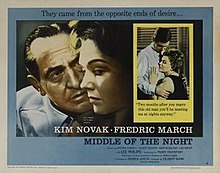fiction.wikisort.org - Movie
Middle of the Night is a 1959 American drama film directed by Delbert Mann, and released by Columbia Pictures.[2][3] It was entered into the 1959 Cannes Film Festival.[4] It stars Fredric March and Kim Novak. The screenplay was adapted by Paddy Chayefsky from his Broadway play of the same name.
| Middle of the Night | |
|---|---|
 Film poster | |
| Directed by | Delbert Mann |
| Written by | Paddy Chayefsky |
| Produced by | George Justin |
| Starring | Fredric March Kim Novak |
| Cinematography | Joseph C. Brun |
| Edited by | Carl Lerner |
| Music by | George Bassman |
| Distributed by | Columbia Pictures |
Release date |
|
Running time | 118 minutes |
| Country | United States |
| Language | English |
| Box office | $1.5 million (est. US/ Canada rentals)[1] |

Plot
A 24-year-old divorcee, Betty Preisser, a receptionist for a clothing manufacturer, takes some office work home which her boss, widower Jerry Kingsley, a man of 56, drops by to pick up. Professional rather than personal acquaintances, Betty tells Jerry of her loveless marriage to George, a musician. Jerry has a married daughter, Lillian, about her age, and a spinster sister, Evelyn, who is very protective of him.
Jerry works up the nerve to invite Betty to dinner. He meets Betty's mother, Mrs. Mueller, and sister Alice, who share the apartment with Betty. Their relationship grows, but she professes to be reluctant to date her employer. Jerry wonders if their age difference is really behind this reluctance. Despite this, a May–December relationship between them develops.
Female family members of both of them strongly disapprove. Mrs. Mueller calls him a "dirty old man," while Jerry's sister calls Betty a "fortune hunter" and him a fool, although Lillian's husband Jack offers his congratulations, earning scorn from his wife and causing them to quarrel. A colleague, Walter Lockman, trapped in a long and unhappy marriage, urges Jerry to do whatever it takes to find true happiness.
George returns to town and tries to persuade Betty to return to him. In a moment of weakness, they have a romantic tryst. Betty regrets it and explains to Jerry that it meant nothing to her emotionally, but he feels humiliated. His sister observes how depressed Jerry has become when he returns home. At his lowest ebb, he learns that Walter has taken an overdose of pills in a likely suicide attempt. Jerry sees it as a sign to seize the joy in life while he still can. He returns to Betty.
Cast
- Fredric March as Jerry Kingsley
- Kim Novak as Betty Preisser
- Glenda Farrell as Mrs. Mueller
- Albert Dekker as Walter Lockman
- Martin Balsam as Jack
- Lee Grant as Marilyn
- Lee Philips as George Preisser
- Edith Meiser as Evelyn Kingsley
- Joan Copeland as Lillian
- Betty Walker as Rosalind Neiman, the widow
- Lou Gilbert as Sherman
- Rudy Bond as Gould
- Effie Afton as Mrs. Herbert, the neighbor
- Jan Norris as Alice Mueller
- David Ford as Paul Kingsley
- Lee Richardson as Joey Lockman
TV play
The story originally appeared as an episode of The Philco-Goodyear Television Playhouse.
Production
Frank Thompson designed the costumes for the film.[5] Future Oscar winners Martin Balsam (A Thousand Clowns, 1965) and Lee Grant (Shampoo, 1975) also star in this film, which was mildly controversial in its day. It was originally a stage play starring Edward G. Robinson. Some of the stage cast were in the film.
Reception
Bosley Crowther, in a mixed but approving review for The New York Times, said that the film "fitly" brings Chayefsky's play to the screen, but found it bleaker than the play, which had touches of ethnic humor that the film does not:
The characters are more intense and driven by their lonely and neurotic moods [than are those in the play]. They fumble and paw at each other in a more avid and frenzied way, and their squabbles and indecisions are more violent and sweaty with pain. Mr. Chayefsky and Delbert Mann, the director, have worked for the taut, dramatic thing. They haven't wasted much time on humor. This is loneliness, boy, and it is grim. But something that was quite attractive on the stage is not in the film. That is the humor and the temperament of a particular ethnic group. Mr. March is an excellent actor when it comes to showing joy and distress but he isn't successful at pretending to be a Jewish papa and business man.[6]
Awards
- Palme d'Or, Cannes Film Festival - nominated
- Best Actor Golden Globe (Fredric March) - nominated
- Top Ten Films of the Year, National Board of Review
References
- "1959: Probable Domestic Take", Variety, January 6, 1960 p 34
- Variety film review; May 20, 1959, page 6.
- Harrison's Reports film review; May 23, 1959, page 82.
- "Festival de Cannes: Middle of the Night". festival-cannes.com. Retrieved February 14, 2009.
- Peter Kihiss (June 7, 1977). "Frank Thompson, Top Designer Of Costumes for Stage and Ballet". The New York Times.
- Crowther, Bosley (June 18, 1959). "Lonely People; 'Middle of the Night' is at Two Theatres". The New York Times. Retrieved May 8, 2022.
External links
- Middle of the Night at IMDb
- Middle of the Night at the TCM Movie Database
- Middle of the Night at AllMovie
Другой контент может иметь иную лицензию. Перед использованием материалов сайта WikiSort.org внимательно изучите правила лицензирования конкретных элементов наполнения сайта.
WikiSort.org - проект по пересортировке и дополнению контента Википедии